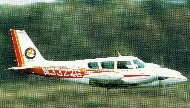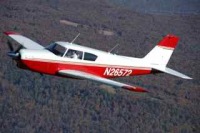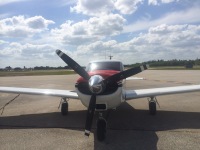We have a Comanche 250 with a Lycoming 0-540-A1D5. In the past year during climbout, we are seeing engine temps climb very quickly to the 400-430f range. When the airplane levels out, the temps quickly come back to normal ranges. We live at Altitude (6500 ft), but until recently, we have never experienced this before.
Any suggestions would be appreciated.
Thanks
David Begin
Engine Cylinder Overheating
14 posts
• Page 1 of 1
Re: Engine Cylinder Overheating
I too have a 250' and that is definetly high. Which cylinder?
I would start with baffles.
Andrew
61250
I would start with baffles.
Andrew
61250
- Andrew Foster
- ICS member

- Posts: 161
- Joined: Fri Dec 31, 2004 9:22 pm
Re: Engine Cylinder Overheating
Ditto Andrew's comment on baffles.
I don't know if the singles have an issue common to Twins. When the Twin's cowling has been removed and replaced, the forward baffles frequently are pushed so that air gets by them on the outside instead of getting pushed over the cylinders. It has happened so often in the past, our shop now tells us that they have checked and the baffles are positioned correctly.
Hopefully it could be something that simple. I'll be interested to hear if baffles are the answer.
I don't know if the singles have an issue common to Twins. When the Twin's cowling has been removed and replaced, the forward baffles frequently are pushed so that air gets by them on the outside instead of getting pushed over the cylinders. It has happened so often in the past, our shop now tells us that they have checked and the baffles are positioned correctly.
Hopefully it could be something that simple. I'll be interested to hear if baffles are the answer.
Pat
Patricia Jayne (Pat) Keefer ICS 08899
PA-39 #10 Texas
Patricia Jayne (Pat) Keefer ICS 08899
PA-39 #10 Texas
-

N3322G - ICS member

- Posts: 1911
- Joined: Thu May 08, 2008 1:58 pm
- Location: Fort Worth, Texas area
Re: Engine Cylinder Overheating
It is usually cylinder 3, 4 or 5.
- David Begin
- Posts: 10
- Joined: Wed Jul 04, 2012 8:16 pm
Re: Engine Cylinder Overheating
David,
Dirty air filter also crossed my mind - with the drought air filters can get dirtier faster.
Dirty air filter also crossed my mind - with the drought air filters can get dirtier faster.
Pat
Patricia Jayne (Pat) Keefer ICS 08899
PA-39 #10 Texas
Patricia Jayne (Pat) Keefer ICS 08899
PA-39 #10 Texas
-

N3322G - ICS member

- Posts: 1911
- Joined: Thu May 08, 2008 1:58 pm
- Location: Fort Worth, Texas area
Re: Engine Cylinder Overheating
David,
On my 250 the #5 cylinder is always the hottest; sometimes in the summer time it will reach 400 when climbing. What airspeed are you climbing? Being at 6500 MSL, definitely harder to climb than at sea level, but it does seem too high.
Mark
On my 250 the #5 cylinder is always the hottest; sometimes in the summer time it will reach 400 when climbing. What airspeed are you climbing? Being at 6500 MSL, definitely harder to climb than at sea level, but it does seem too high.
Mark
-

Mark Anderson - ICS member

- Posts: 196
- Joined: Sat Aug 29, 2009 12:24 am
- Location: Huntsville , AL
Re: Engine Cylinder Overheating
David,
Maybe a quick timing check my be a good idea as well
Andrew
Maybe a quick timing check my be a good idea as well
Andrew
- Andrew Foster
- ICS member

- Posts: 161
- Joined: Fri Dec 31, 2004 9:22 pm
Re: Engine Cylinder Overheating
Check your baffles. Make sure all of the soft baffle material is pointed in to the pressure so that the cooling air causes it to seal harder rather than pushes it open and letting the air out. Now with that said, your engine has a red line of 500 degrees CHT, and Lycoming says for best longevity keep normal operating temperatures below 485, and by normal they mean cruise temps. So, check your baffles if you have seen a recent change, and fix what you find. If you don't find anything, fly on! So many people get so worried about CHTs above 400. Most of this comes from reading Mike Bush articles. I like Mike, and he has some very good info, but he is a Continental guy. His numbers and experience lean that direction. The Lycoming engines are designed to run hotter and they do, with no adverse effects. Before the advent of the multi probe digital engine analyzer, most engines ran hotter but nobody cared, and they still made TBO. Use the tools to help diagnose problems. Don't get wrapped up trying to solve a "problem" you may not have.
"Keep it above 5 feet and don't do nuthin dumb!"
-

Zach Grant L1011jock - Technical Advisor
- Posts: 1404
- Joined: Mon Mar 22, 2004 4:35 pm
- Location: Indianapolis KEYE
Re: Engine Cylinder Overheating
Zach is spot on... check your baffles. I always claimed that like Hans's mine are as tight as a frog's butt. However, having not flown lately, I have been running the engines up about 1x per month for 15 to 20 minutes... as we are starting to get some non frozen tundra weather here... I noticed that on my right engine... #2 and #4 were running about 30 to 40 degrees warmer than 1 & 3... the left engine was normal...
Well guess what, during re-installing the cowling last spring, I had not gotten the nose pieces back on and had a piece of baffle in-op.
Can't stress that enough... when I had a single 260 #5 was always the hottest until I got the baffle frenzy and tightened them up.
Jim
Well guess what, during re-installing the cowling last spring, I had not gotten the nose pieces back on and had a piece of baffle in-op.
Can't stress that enough... when I had a single 260 #5 was always the hottest until I got the baffle frenzy and tightened them up.
Jim
- MULEFLY
- ICS member

- Posts: 900
- Joined: Tue Jan 25, 2000 1:34 am
- Location: Wisconsin
Re: Engine Cylinder Overheating
I am seeing the exact problem! On climb out I've seen 3,4,5,6 at 440-460 range. The only difference for me is I just had a dual mag change. Timing is solid baffles haven't been touched. I don't think I would stress except the problem just appeared from no where. Also does anyone have the EI fuel gauge? It is supposed to show HP but I don't think at 3000 the engine will only give 40% power. The engine seems to give excellent power, but the gauge is off.
climb out,
25rpm/25map
115-120 mph/knots
From sea level - to cool my CHTs i can only climb at 500 fpm or so and I have to reduce power.
Thoughts?
PA-250
IO-540 A15A
Kris
climb out,
25rpm/25map
115-120 mph/knots
From sea level - to cool my CHTs i can only climb at 500 fpm or so and I have to reduce power.
Thoughts?
PA-250
IO-540 A15A
Kris
- Kristofer Duckett
- ICS member

- Posts: 98
- Joined: Thu Aug 05, 2010 6:52 am
Re: Engine Cylinder Overheating
Kris,
Read my response above. Baffles baffles baffles!!!!! First, your red line is set wrong on your JPI if you are using it as a primary. You should be a 500 degree CHT redline. Next, if you have a carbureted engine DONT PULL THE THROTTLE BACK IN CLIMB. If your baffles are good, but OATs are high, you can see the numbers you posted in the pic, and what you have left is fuel to cool. Pulling the throttle back in climb actually leans the engine. There is absolutely nothing wrong with climbing at wide open throttle. Why pull the throttle back to 25" only to have to push it back in as you climb. Over square is an old wives tail. One has nothing to do with the other. You could just as easily read power in degrees per second and feet of water for example if that was what was used at the time (and then the numbers wouldn't even be close). You want to climb out of the heat as quickly as possible. Just a 10 degree difference in OAT makes a huge difference in cooling efficiency.
Zach
Read my response above. Baffles baffles baffles!!!!! First, your red line is set wrong on your JPI if you are using it as a primary. You should be a 500 degree CHT redline. Next, if you have a carbureted engine DONT PULL THE THROTTLE BACK IN CLIMB. If your baffles are good, but OATs are high, you can see the numbers you posted in the pic, and what you have left is fuel to cool. Pulling the throttle back in climb actually leans the engine. There is absolutely nothing wrong with climbing at wide open throttle. Why pull the throttle back to 25" only to have to push it back in as you climb. Over square is an old wives tail. One has nothing to do with the other. You could just as easily read power in degrees per second and feet of water for example if that was what was used at the time (and then the numbers wouldn't even be close). You want to climb out of the heat as quickly as possible. Just a 10 degree difference in OAT makes a huge difference in cooling efficiency.
Zach
"Keep it above 5 feet and don't do nuthin dumb!"
-

Zach Grant L1011jock - Technical Advisor
- Posts: 1404
- Joined: Mon Mar 22, 2004 4:35 pm
- Location: Indianapolis KEYE
Re: Engine Cylinder Overheating
An old Piper guy told me to always climb out at 120 knots to keep her cool and it works. I flew my single in hot humid Florida and on most days a 90 knot climb out after takeoff almost guaranteed a hot engine in my experience.
-

Randy Johnson - Posts: 176
- Joined: Thu Apr 14, 2011 1:57 am
- Location: Boston Area (BEV)
Re: Engine Cylinder Overheating
I have a different problem on my 250. Seems the #2 cylinder is always my hot cylinder in a climb. Puzzling, I would expect the front cylinders to be the coolest.
Baffles appear to be in very good shape.
I do appear to have a cowling that was designed for two exhausts but I only have one exhaust installed. Not sure if that has anything to do with #2 running hot.
On a descent I have the opposite problem, #2 cools much quicker and I get the shock cooling alert.
Mechanic bore scoped the cylinder and everything looked good.
Baffles appear to be in very good shape.
I do appear to have a cowling that was designed for two exhausts but I only have one exhaust installed. Not sure if that has anything to do with #2 running hot.
On a descent I have the opposite problem, #2 cools much quicker and I get the shock cooling alert.
Mechanic bore scoped the cylinder and everything looked good.
-

Richard Lanning - Posts: 65
- Joined: Tue Apr 15, 2014 11:08 pm
- Location: South Florida
Re: Engine Cylinder Overheating
Recently I started having #2 hot on climbout. This seemed to start after an IFR departure, my first, with cloud cover and I forgot to raise the LG. About 15 mins into the flight I noted my Airspeed was very slow (apparently my scan needs work) and what triggered me to look at my airspeed was my #1 and #2 temps were far higher than normal for cruise. I retracted LG and the temps on #1 and #2 came down (never exceeded 400F). Now on climbout my #2 runs the warmest by 50F but cools when I level off.
I will check baffles.
Vince
I will check baffles.
Vince
- Vince Hoffart
- Posts: 21
- Joined: Sun Jan 08, 2017 10:42 am
14 posts
• Page 1 of 1
Return to Maintenance - Powerplant
Who is online
Users browsing this forum: No registered users and 2 guests
